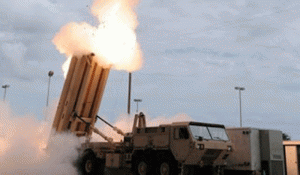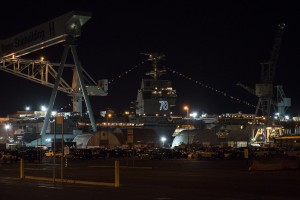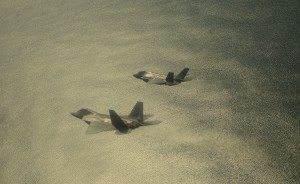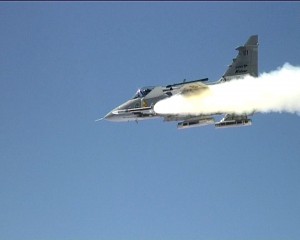2014-02-23 by Robbin Laird
No platform fights alone. Technology is increasingly playing a forcing function for significantly greater integration among combat elements in shaping core combat capabilities.
The digital enablement of key combat platforms – missile defense, combat air, unmanned systems, ground force connectivity via data links – is providing a forcing function role upon the next phase of the evolution of 21st century systems.
For the technological potential to be unlocked, it is necessary to change approaches to organization, procurement, and concepts of operation (CONOP). The decade ahead will see significant technological pressure upon traditional approaches and, at the same time, provide openings for significant organizational, procurement, and CONOP innovations.
One way to understand the dynamics of change is to examine the emergence and evolution of what might be called the aerospace or air combat cloud. Here various aerospace assets can work more effectively together to shape combat capabilities in, through, and across all domains. It is about enabling ground, air and maritime concepts of operation, focused, and joint.

Nonetheless, without much greater integration disparate assets will not be able to work more cohesively together.
Key platforms are fifth generation aircraft that can accelerate change in creating the aerospace combat cloud. In an interview with the Commander of the Air Combat Command, General Hostage, the interaction between fifth generation aircraft (as fleets) and the opportunity to change concepts of operations were highlighted.
The core image, which the General put on the table of where the transition needs to go, is the ability to shape a “combat cloud” as a key element of the battlespace within which the various deployed aircraft interact together to shape air dominance to achieve joint force objectives.
This combat cloud would be enabled by fifth generation aircraft and include the deployment of F-22s, a substantial number of F-35s and the ability to link to legacy aircraft. This capability would then define the approach to any systems added thereafter, such as the long-range ISR/strike aircraft.
According to Hostage: the fifth generation aircraft will enable the air combat cloud and allow me to use my legacy assets differently.
Many of my 4th Generation fighters can be used to extend the network of linked systems providing reinforcing fires, and I can focus on the fifth generation assets as the core nodes shaping distributed joint capabilities.
And when we come to the evolution of “next” generation systems, the form factor could stay quite similar as we evolve the capabilities within the planes or in terms of how the flying systems can interact and operate together.
Rather than thinking of 6th generation aircraft in form factor terms, we can operate the new air combat cloud and leverage that moving forward.
To further explore the concept and the building blocks for an aerospace combat cloud capability, I talked with one of the innovators in developing such a concept, Lt. General (retired) Dave Deptula.
Deptula is Dean of the Mitchell Institute for Airpower Studies of the Air Force Association. The Institute is beginning a look at the cross service efforts to shape this new approach to airpower in the decade ahead.
In this interview, Deptula discusses some of the key elements of the approach.
Deptula: A way to think about this is the shift from the industrial age of warfare to the information age of warfare. Technology has a piece in this; organization has a piece in this and concepts of operation have an even larger piece in the evolution of cloud combat capability.
The U.S. military is now at a juncture where the speed of information, advances in stealth and precision strike, next-generation sensors, and other technologies will permit it to move beyond a combined arms warfare construct of segregated land, air, and sea operations.
This shift will not come easy, as many in the U.S. military have been inculcated with a belief in the combined arms approach and, in some cases, continue to adhere to the anachronistic belief that airpower should only be used as a supporting arm of land and sea operations.
In lieu of adhering to linear, industrial age operational approaches that mass forces to wage wars of attrition, DoD could create a new joint operational concept for combined effects warfare that integrates the functions of ISR, precision strike, maneuver, and sustainment to achieve desired effects across all operating domains.
This joint concept should explain how the U.S. military could link information-age aerospace systems with sea and land-based weapons systems in ways that will enhance their combined effectiveness and compensate for the vulnerabilities of each.
A resulting ISR, strike, maneuver, and sustainment complex could be described as a “combat cloud” that uses information age technologies to conduct highly interconnected, distributed operations.
The combat cloud concept is somewhat analogous to “cloud computing,” which is based on using a network (e.g., the Internet) to rapidly share information across a highly distributed system of systems.
Instead of combining the computing power of multiple servers, however, a combat cloud would capitalize on C4ISR networks to rapidly exchange data across an all-domain architecture of sensors and shooters to increase their effectiveness and achieve economies of scale.
If enabled by secure, jam/intrusion-proof connectivity, a combat cloud may be capable of employing fewer modern combat systems to achieve higher levels of effectiveness across larger areas of influence compared to legacy operational concepts.

For example, instead of relying on traditional approaches that mass fighters, bombers, and supporting aircraft into major strike packages to attack particular targets, a combat cloud could integrate complementary capabilities into a single, combined “weapons system” to conduct disaggregated, distributed operations over a fluid operational area.
A distributed, all-domain combat cloud that is difficult to attack effectively and nearly self-healing if attacked would also complicate an enemy’s planning and compel it to dedicate more resources toward its defense.
Question: When we met with General Hostage, he highlighted the importance of fifth generation aircraft to the next phase of airpower seen from the could perspective, and how would you highlight their impact?
Deptula: Although the F-22s and F-35s are labled “Fs,” or fighters, they are not classic “fighters” as what we labeled fighters in the industrial age at all. They are flying sensor nodes that also have the capability to employ weapons, either air to air or air to surface.
They have the ability to penetrate and operate in contested and denied air space and in many cases we will probably value them more for their ability to operate in contested air space, collect information, transmit it back to the other combat elements which can then use that information in developing their operational responses.
These systems are leading us into an era where we can create a cohesive, war fighting complex not just limited to air operations, but to the maritime and land domains as well.
Question: Technology facilitates this capability but organizational redesign is crucial. Could you elaborate?
Deptula: The services are currently not aligned to shape a common aerospace combat cloud. Alignment to achieve this capability is crucial at this point in the evolution of airpower. We need to realign our research and development approaches with the cloud, rather than continuing to follow the segregated, stove-piped approaches that have been the hallmark of military organization since the days of Clausewitz.
We need to think beyond a very narrow traditional, “requirements-based” approach and focus upon aligning contributions to an ISR—strike—maneuver—sustainment complex or a “combat cloud.”

We need as well to put an end the separation of kinetic and non-kinetic capabilities as we rethink the future of weapons development enabled by the aerospace combat cloud.
Question: Obviously, what you are talking about embraces both rethinking joint as well as coalition perspectives. And this can embrace significant change in how we think about leveraging assets bought as a coalition. What is your perspective on the coalition possibilities?
Deptula: For example, if we take a consortium approach to security strategy we should consider the integrated application of capability resident in partner nations. We may be able to achieve much more capable outcomes than we otherwise achieve by pursuing traditional weapon system acquisition.
Question: This will lead as well to thinking about different concepts of operations to achieve mission objectives. What is your thinking on this challenge?
Deptula: We really need not just new conceptual constructs; we need to embrace truly joint organizational constructs that will actualize the combat cloud architecture. There needs to be a convergence of capability that will result in the design, development and actualization of a combat cloud by the different service components.
This is the challenge, but also the opportunity for a significant enhancement in 21st century relevant combat capabilities.
Robust, reliable anti-jam, anti-tamper methods of communication are key elements of the effort.
I do not just limit this to, I should say, methods of communication as opposed to links because there are ways to share information without relying on traditional links, and that will be part of the combat cloud design function as it evolves.
Again this concept is not just based on technology. It is also based on organization and the distribution of knowledge and understanding of guidance for how individual units might play so that you can have graceful degradation if the entire system is not operating with 100 percent contribution of each element.
In other words, it is not just about data-links or net-centricity, it is about a concept where even if you have degradation of your optimal information sharing construct you are still operating in a venue where you are very, very effective.
Appendix: Lt. General (Retired) Deptula: An Assessment of the Nature and Importance of the Evolving Aerospace Combat Cloud
The U.S. military is now at a juncture where the speed of information, advances in stealth and precision strike, next-generation sensors, and other technologies will permit it to move beyond a combined arms warfare construct of segregated land, air, and sea operations.
This shift will not come easy, as many in the U.S. military have been inculcated with a belief in the combined arms approach and, in some cases, continue to adhere to the anachronistic belief that airpower should only be used as a supporting arm of land and sea operations.
In lieu of adhering to linear, industrial age operational approaches that mass forces to wage wars of attrition, DoD could create a new joint operational concept for combined effects warfare that integrates the functions of ISR, precision strike, maneuver, and sustainment to achieve desired effects across all operating domains.

This joint concept should explain how the U.S. military could link information-age aerospace systems with sea and land-based weapons systems in ways that will enhance their combined effectiveness and compensate for the vulnerabilities of each.
A resulting ISR, strike, maneuver, and sustainment complex could be described as a “combat cloud” that uses information age technologies to conduct highly interconnected, distributed operations. The combat cloud concept is somewhat analogous to “cloud computing,” which is based on using a network (e.g., the Internet) to rapidly share information across a highly distributed system of systems.
Instead of combining the computing power of multiple servers, however, a combat cloud would capitalize on C4ISR networks to rapidly exchange data across an all-domain architecture of sensors and shooters to increase their effectiveness and achieve economies of scale.
If enabled by secure, jam/intrusion-proof connectivity, a combat cloud may be capable of employing fewer modern combat systems to achieve higher levels of effectiveness across larger areas of influence compared to legacy operational concepts.
For example, instead of relying on traditional approaches that mass fighters, bombers, and supporting aircraft into major strike packages to attack particular targets, a combat cloud could integrate complementary capabilities into a single, combined “weapons system” to conduct disaggregated, distributed operations over a fluid operational area.
A distributed, all-domain combat cloud that is difficult to attack effectively and nearly self-healing if attacked would also complicate an enemy’s planning and compel it to dedicate more resources toward its defense.
The “air combat cloud” requires treating and equipping every platform as a sensor as well as a “shooter” (defined as an ability to achieve a desired effect).
It will require a command and control (C2) paradigm that enables automatic linking as does cell-phone technology today (moving from one cell zone to another is transparent), and transfer of data seamlessly, and without need for human interaction within and/or between the air combat cloud nodes, plus it must be reliable, secure, and anti-jam proof.
We need to realize and exploit the advantages of modern aerospace and information age technology to build new cost-effective concepts of operation. However, one of our challenges is that people still tend to view cost in terms of individual unit cost, as opposed to cost per desired effect that better reflects real value—and that is where we need to move the discussion and decision space.
We need to realize and exploit the advantages of modern aerospace and information age technology to build new cost-effective concepts of operation. However, one of our challenges is that people still tend to view cost in terms of individual unit cost, as opposed to cost per desired effect that better reflects real value—and that is where we need to move the discussion and decision space.
We need to think beyond the constraints that traditional military culture imposes on new technology. For example, 5th generation aircraft such as the F-35 are termed “fighters,” but technologically, they are not just “fighters”—they are F-, A-, B-, E-, EA, RC, AWACS-35s. They are flying “sensor-strikers” that will allow us to conduct information age warfare inside contested battlespace whenever we desire—if we fully exploit their “non-traditional” capabilities to the degree that those capabilities become accepted as the new “traditional.
This will require leading-edge networking capabilities, and different approaches to solving our data bandwidth challenges. For example, to solve the explosion in data growth from new sensors, instead of building bigger pipes to transmit all the collected data, we ought to process the data on-board and only transmit what’s of interest to the users. This approach inverts the way we do intelligence, surveillance and reconnaissance processing today—and it has the potential for doing so quicker, better, and cheaper.
To fully capitalize on these capabilities will require a new way of designing our force. We need to also realize that innovation can be applied to organization as well as from technology. We have to think outside of the organizational constructs that history has etched into our collective psyche. Network-centric, interdependent, and functionally integrated operations are the keys to future military success.

The future needs an agile operational framework for the integrated employment of allied military power. It means taking the next step in shifting away from a structure of segregated land, air or sea warfare that has come to be know as combined arms warfare, to integrated operations based on the four functions of ISR, strike, maneuver, and sustainment to achieve desired effects—or combined effects warfare.
We’re at a critical juncture in history—at the center of an Information in War Revolution—one where the speed of information, advance of technology, and designs of organizations are merging to change the way we operate. This change has dramatically shortened decision and reaction times, and reduced the number of systems it takes to achieve desired effects.
However, we can fail to realize the full potential of airpower, based on how we look at it. Just as we label the F-22s and F-35s with a traditional naming convention as a fighter—even though they are much more than that—we tend to view remotely piloted aircraft in terms of how well they can observe and destroy targets. This is a combined arms perspective.
Airpower provides us much more than simply combined arms platforms. To fully exploit its versatility, we need to pay more attention to combined effects. This paradigm shift will not come easy, as thousands of years of history has inculcated us with a combined arms approach. But we know that precise targeting does not always give us precise effects. So we have to anticipate second, and third, and higher orders of effect in the employment of every aspect of airpower.
For example, look at the observer effect that remotely piloted aircraft have extended to modern warfare. The simple act of observation has caused strategic disruption of terrorist adversaries. When we observe an enemy—and they are aware of the precision effects that can be immediately employed when seen—we dramatically change their behavior.
We know that aerospace systems give us more tools, but they don’t automatically give us better answers. That’s why humans need to stay in the technology loop. We know remotely piloted aircraft provide us reams of ISR data, but we need real-time analytic processing to make better decisions.
Similarly, we need to anticipate threats beyond those posed by combined arms, because our adversaries use any available means at their disposal. A short list would include cyber attacks, crowd sourcing, and distributed command and control—online.
Desired effects should determine our engagement methods, and force application is only one of a spectrum of options. In fact, an effects-based approach is a springboard for better linking military, economic, information, and diplomatic instruments of power to conduct security strategy in depth.
If we focus on combined effects warfare—the end of strategy, rather than force-on-force—the traditional means to achieve it, what we have become accustomed to calling combined arms warfare—we can consider more effective ways to accomplish the same goal more quickly than in the past, with fewer resources, and most importantly, with fewer casualties.

Airpower allows us to do that. It can be intertwined with, and contribute to all elements of power—diplomatic, informational, military, economic and social. But it requires a broader perspective than traditionally applied to airpower in the past—beyond a supporting arm in the combined arms equation. We need to seek being able to integrate aerospace forces with each of these elements in an interdependent manner.
We need to link aerospace and information-age capabilities with sea and land-based means to create an omni-present defense complex that is self-forming, and if attacked, self-healing. This kind of a complex would be so difficult to disrupt that it would possess a conventional deterrent effect that would be stabilizing to whatever region it is deployed.
The central idea is cross-domain synergy. The complementary vice merely additive employment of capabilities in different domains such that each enhances the effectiveness, and compensates for the vulnerabilities, of the others.
This combined effects approach is about integrating existing and future aerospace capabilities within an agile operational framework guided by human understanding. It’s an intellectual construct with technological infrastructure.
Editor’s Note: Deptula has developed these propositions in various speeches over the past few months and this appendix has pulled together several of these propositions into a single statement.

